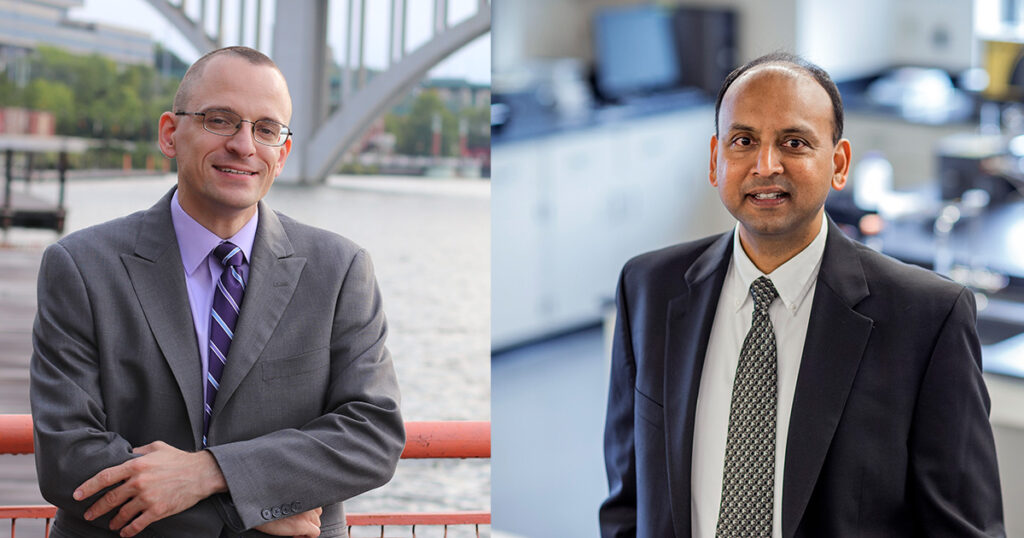A fusion reactor fueling a city for generations. A rocket launching into space with its twentieth payload. A hypersonic jet outrunning a missile going Mach 8, then returning home to be refueled and flown again.
Such devices are on the horizon, but they demand more of their components than current materials can give.
“These next-generation technologies need to withstand combined high temperature, high pressure, and sometimes exposure to radiation or corrosive conditions—some of them for decades,” said Fred N. Peebles Professor Dayakar Penumadu. “Suitable materials for that don’t exist today.”
Materials scientists think such multi-resistant materials will be achieved by alloying the refractory metals, nine elements known to be highly resistant to heat and wear. Instead of the relatively simple alloys of the past, the needed materials will likely be compositionally complex alloys made of three or more elements in approximately equal proportions.
Such mixtures have already resulted in materials with properties beyond what can be explained by simple combination or averaging of their component elements.
“Unfortunately, the large composition space available makes it difficult to explore all the possible combinations of refractory alloys,” said Stephen Puplampu (PhD ’19), a postdoctoral fellow working with Penumadu and Associate Professor Timothy Truster.
However, with a new approach, Penumadu, Truster, and Puplampu are helping accelerate the discovery of the ideal multi-resistant alloys.
This June, the University of Tennessee received $18 million from the National Science Foundation to establish the first and only Materials Research Science and Engineering Center (MRSEC) in the southeastern US.
Each MRSEC is a hub for interdisciplinary materials science and education, where national experts collaborate to tackle fundamental engineering issues with broad societal impact.
“Other MRSECs exist at places like Columbia University, Harvard, and Princeton,” Truster said. “To be part of this prestigious group really says that UT is up and coming—that we have the resources and the people to tackle large societal challenges. Our university is being recognized as a leader in material science.”
The UT Knoxville Center for Advanced Materials and Manufacturing includes two interdisciplinary research groups (IRGs). The researchers in IRG1 are dedicated to quantum materials and systems, while those in IRG2—including Penumadu, Truster, and Puplampu—are exploring materials for use in extreme environments.
The materials scientists of the IRG2 team are creating a large series of thin films, each made with a gradient of alloy compositions. The films are then subjected to a battery of tests, letting the researchers determine the properties of many potential alloys at once.
Penumadu’s team conducts nanoindentation studies on each film, evaluating how the alloys’ mechanical properties like elasticity and viscosity change under extreme temperatures and pressures. They then scrutinize the materials using novel radiation-based scattering, diffraction, and imaging techniques that incorporate both neutrons and X-rays.
“Our evaluation will be used to link the synthesis, structure, and property relationships of the materials,” Penumadu said. “This allows our colleagues in materials science to generalize rapid discovery of materials for use in extreme environments.”
Truster’s team then performs multi-physics finite element simulations of the materials, incorporating data from Penumadu’s nanoindentation experiments and from atomic-scale simulations by other members of IRG2. Truster’s simulations reveal how thicker sheets of each alloy would perform under various stresses.
“Current experimental techniques can only provide surface imaging and load-displacement curves,” Truster explained. “Properly calibrated modeling can provide more information about what is going on below the surface. We can even simulate the material’s performance in scenarios that were not experimentally tested. If their simulated performance is not satisfactory, we can suggest revisions for the next round of manufactured thin films.”
This loop of material development, testing, evaluation, and simulation will help the IRG2 team move rapidly and efficiently through the massive space of possibilities.
“It’s a highly interdisciplinary project,” Penumadu said. “We are synergizing multiscale computational mechanics from Dr. Truster’s group, multiscale material characterization from my group, and the alloy development from our materials scientists.”
The highly collaborative environment will not just facilitate the discovery of next-generation materials—it will also help IRG2’s researchers educate the next generation of flexible and multidisciplinary scientists.
Both graduate and undergraduate students are helping Penumadu with nanoindentation experiments and Truster with materials simulations. Students are also deeply involved in the other teams within CAMM.
“We don’t distinguish between departments, or between students and faculty. We’re just a part of a research group,” said Penumadu. “Everyone is contributing their strengths to the overall success of the project. That’s a very unique attribute of a MRSEC.”
The multidisciplinary environment enriches the faculty as well, fostering a community of researchers who think far outside the bounds of their traditionally defined disciplines.
“Even in the last four months since CAMM started, our meetings have been unlike any of my previous experiences, either in grad school or as faculty,” Truster said. “I’m learning from experts outside my comfort zone of mechanics. Being a small part of this center will certainly elevate my research, even as I help to develop complex materials to meet the nation’s future needs.”
Contact
Izzie Gall (865-974-7203, egall4@utk.edu)
